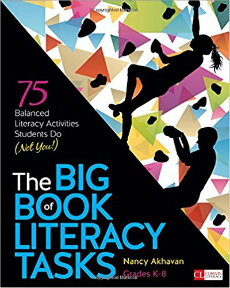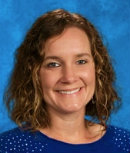Literacy Activities That Students Do (Not You!)
The Big Book of Literacy Tasks Grades K-8: 75 Balanced Literacy Activities Students Do (Not You!)
By Nancy Akhavan
(Corwin, 2018 – Learn more)
Reviewed by Stacy Thorpe
The Big Book of Literacy Tasks: 75 Balanced Literacy Activities Students Do (Not You!) offers a learning facilitator ample opportunities to reflect on a student’s role as an active participant in their own learning and literacy development.
Nancy Akhavan has authored a book that provides research based ideas for developing readers and writers in grades K-8. These activities are not explicit lesson plans that tell a teacher exactly what materials to use and how to present them, but rather a collection of strategies that good readers and writers use to develop their own connections and ideas. These literacy tasks will help teachers foster student thinking while modeling what good readers and writers achieve.

Each task contains an instructional playbook that tells you
- how to present the strategy and what you may say to students
- an example of what typical successes look like
- how to model and tweak your instruction to get the best results, and
- watch-fors and workarounds to help you address the potential challenges that may arise when students are not performing the tasks.
Tasks for every day
The Everyday Tasks are 35 activities designed to build skills that good readers and writers use each and every time they read and write. These tasks help students make connections, learn to read and write with purpose, and most importantly, think about reading and writing. Included in this section are tasks for developing focus, using details to support comprehension, and collaborating with peers.
Task 34 is Works Too Long and Never Gets Any Writing Done (I think I have had this writer in every writing group I have taught!). This lesson helps a teacher facilitate writing organization through modeling, peer support, and the use of a FOCUS framework that guides students to completed piece of writing.
Tasks for weekly reading and writing
Next, Akhavan provides 14 Weekly Tasks that are more specific and take more time for students to complete. These tasks involve use of more complex texts in reading and more specific output requirements for writing assignments. The skills presented in this section include creating an outline, organizing research, sharing writing with an audience, and writing a book report.
Task 50 addresses the book report. Responding to Literature With Some Kick to It goes beyond a basic summary that includes important characters, events and big ideas, and encourages students to give their opinion and honest recommendation to read or not read the book.
Some tasks for deeper digging
The Sometimes Tasks are the most demanding tasks in the book. These tasks require more student thinking and a deeper dig into the literacy experience. They invite students to make connections between texts, to use peer-to-peer analysis, to think aloud, and to critique the validity of a text.
Task 70, Creative Debate, invites students to take on the perspective of a character and debate that character’s side of a conflict or controversial issue from the book. Akhavan includes a Debate Planning Sheet to help students narrow their focus and efficiently present their argument and information.
The final piece of this book that I’d like to mention are the reproducible forms. Instead of questions that are specific to a piece of writing, Akhavan gives teachers checklists that encourage student thinking and reflection. These forms include Conversations About the Texts, My Strategies for Independence, Checking My Understanding, Making Connections, and Identifying the Central Idea.
Encourage students to reflect
Overall, this book inspired me to think about the learning tasks that I present in class. Akhavan encourages teachers to push away from assigned passages with worksheets that require canned responses, and instead promote more freedom in student thinking and more reflection about their connection to the reading and writing going on in their classroom.
Stacy Thorpe teaches Special Education in Gobles, Michigan. She recently completed her Master’s degree in Learning Disabilities at Spring Arbor University. Thorpe is always trying to find new ways to help ALL students grow and learn. When she is not teaching or researching, she is spending time with her husband and three sons: cheering them on in sporting events, enjoying their musical performances, supporting their involvement on Solar Car and Robotics Teams, and enjoying family campouts.


































